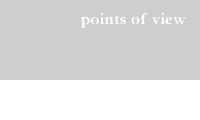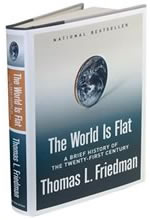

3/2006
A Brief History of the Twenty-First Century, by Thomas L. Friedman (Farrar, Straus, Giroux, New York City, 2005)

reviewed by Stephanie
Stubbs, Assoc. AIA
Managing Editor
 Flat.
Flat. Flat. Go to any lecture these days, and the speaker undoubtedly
will weave The World Is Flat into the
talk. The
World Is Flat pops
up in all kinds of specialty bookstores, including those dealing with
something seemingly unrelated as, say, architecture. Your
sister read it; your niece gave it to you for Christmas; your engineer
loved it (okay—he didn’t read it; he listened to the audiobook).
Flat. Flat. Flat.
Flat.
Flat. Flat. Go to any lecture these days, and the speaker undoubtedly
will weave The World Is Flat into the
talk. The
World Is Flat pops
up in all kinds of specialty bookstores, including those dealing with
something seemingly unrelated as, say, architecture. Your
sister read it; your niece gave it to you for Christmas; your engineer
loved it (okay—he didn’t read it; he listened to the audiobook).
Flat. Flat. Flat.
After almost a year on the New York Times and Washington Post best-sellers lists, The World Is Flat has reached the tipping point of popularity reached by Malcolm Gladwell’s The Tipping Point a few years back. Why is everyone reading and talking about The World Is Flat, a book about globalization, of all esoteric topics?
First, author and New York Times columnist Thomas L. Friedman has a pellucid and compelling style that keeps you reading about stuff you didn’t know you found interesting. Second, Friedman has created an understandable structure on which to build and make sense of the tangle of complex social and economic forces shaping our increasingly globalized and pancaked planet. Third, because many of these forces increasingly touch our daily lives—sometimes with uncomfortable and seemingly inexorable pressure (CELL PHONES!!!)—it is reassuring, if nothing else, to hold them in front of our consciousness rather than allow them to advance on us from behind.
 Ten levels of flat
Ten levels of flat
Friedman begins this thoughtfest with a roundup of 10 forces that flattened
the world, all of which have taken place in the last 16 years. (For
his fascinating observations of how and why, you’ll just have
to read the book.)
Flattener #1. 11/9/89, the day the Berlin Wall came down, and the world
tipped toward democracy
Flattener #2. 8/9/95, the day Netscape went public, and the world tipped
from “a PC-based computing platform to an Internet-based platform”
Flattener #3. Work Flow Software, which allows for discrete portions
of work to be separated from the overall work flow and completed separately
and anywhere
Flattener #4. Open-Sourcing, self-organizing communities that come together
online to collaborate and peer-review the creation of intellectual tools
(Wikipedia comes to mind)
Flattener #5. Outsourcing, taking a task from your workflow, having it
completed elsewhere, and inserting it back into the workflow; the example
Friedman gives is the mining by U.S. companies of India’s intellectual
power and cheap labor to complete Y2K upgrading
Flattener #6. Offshoring, different from
outsourcing, because it moves an entire operation, such as a factory,
and produces “the very
same product in the very same way, only with cheaper labor, lower taxes,
subsidized energy, and lower health-care costs”
Flattener #7. Supply-Chaining, or “collaborating horizontally—among
suppliers, retailers, and customers—to create value”; this
is what Wal-mart does so well, and we as a society remain torn between
the love of lower prices, convenience, and efficiency and hate of its
callousness to workers and the environment, the sameness, the banality
Flattener #8. Insourcing, another form of horizontal collaboration, in
which a company (think UPS) designs, sets up, and manages all the logistics
of your supply chain for you; like Flattener #4, Open-Sourcing, this
step commands an extremely high level of trust
 Flattener #9. In-forming, which means “there is no discrimination
in accessing knowledge,” thanks to Google, Yahoo!, and MSN Web
Search; this is shaping a whole new breed of clients, consumers anywhere
and everywhere, because anyone who can get to a computer can get to information
Flattener #9. In-forming, which means “there is no discrimination
in accessing knowledge,” thanks to Google, Yahoo!, and MSN Web
Search; this is shaping a whole new breed of clients, consumers anywhere
and everywhere, because anyone who can get to a computer can get to information
Flattener #10. The Steroids, “digital, mobile, personal, and virtual” devices,
including all analog, wireless, and handheld tools—digital camaras,
cell phones, digital camera cell phones, iPods, etc.—that enhance
and enable the other nine flatteners.
Three shades of globalization
All these flatteners have been around as ingredients since the 1990s.
However, they needed to converge into the globalization soup we are
dining on today. Friedman posits this happened in three stages, a “triple
convergence,” he calls it. The first convergence happened around
the year 2000: “The net result of this convergence was the creation
of a global, Web-enabled playing field that allows for multiple forms
of collaboration—the sharing of knowledge and work—in real
time, without regard to geography, distance, or in the near future,
even language.” Friedman writes. “No, not everyone has
access yet to this platform, this playing field, but it is open today
to more people in more places on more days in more ways than anything
like it ever before in the history of the world.”
 The second convergence is just coming along now, because it takes time
for the new technologies to be paired with the new ways of doing business
that can result in leaps in productivity. The technologies themselves
were not enough: “We needed the emergence of a large cadre of managers,
innovators, business consultants, business schools, designers, IT specialists,
CEOs, and workers to get comfortable with and develop, the sorts of horizontal
collaboration and value-creation processes and habits that could take
advantage of this newer, flatter playing field.” The Age of the
Mainframe, Friedman explains, is very vertically organized, while Globalization
II, which threw the PC, microprocessor, Internet, and fiber optics into
the soup, is horizontal in nature.
The second convergence is just coming along now, because it takes time
for the new technologies to be paired with the new ways of doing business
that can result in leaps in productivity. The technologies themselves
were not enough: “We needed the emergence of a large cadre of managers,
innovators, business consultants, business schools, designers, IT specialists,
CEOs, and workers to get comfortable with and develop, the sorts of horizontal
collaboration and value-creation processes and habits that could take
advantage of this newer, flatter playing field.” The Age of the
Mainframe, Friedman explains, is very vertically organized, while Globalization
II, which threw the PC, microprocessor, Internet, and fiber optics into
the soup, is horizontal in nature.
Convergence III also is unfolding, as three billion people—in China, India, Russia, Eastern Europe, Latin America, and Central Asia—for the first time have access to the economic playing field. “It is this triple convergence—of new players, on a new playing field, developing new processes and habits for horizontal collaboration—that I believe is the most important force shaping global economics and politics in the early twenty-first century,” Friedman writes.
We see all this coming in snapshots and freeze frames of day-to-day lives and workaday worlds. Friedman does, however, offer a framework around which to order the rapid and radical changes that seem to be driving global, national, local, and even profession-wide economies. After carefully laying out these observations and peppering them with a comfortable number of real-people, real-life examples, he uses the rest of the book to “enter the flat world,” providing examples of how the triple convergence specifically is affecting and will affect Americans, developing countries, and companies.
 What does this have to do with architecture?
What does this have to do with architecture?
In a word or three: BIM (Building Integration Modeling). BIM, a process
in which all members of the building team collaborate on the same set
of 3-D drawings that model the project before it is built, has many
characteristics that make it seem like a mini-globalization of the
profession. Foremost, BIM requires a flattening of the design/detail/build
hierarchy, as all members of the team must work together with capital-T
Trust. Such an integrated practice approach creates a seamless “supply
chain” of decisions that must be managed and plugged in at just
the right time. And the emphasis of the work flows “up,” as
there is less drafting and more design in BIM than in the traditional
design-bid-build process. And all the “steroids” that pump
up the flat world make BIM easier to do every day.
Perhaps it is venturing not too close to the planet edge to posit that the Brave Flat World contains a roadmap for where the Institute will travel in the near future as we prepare for our sesquicentennial celebration in 2007. Surely the signs of flattening are there as we strive to be more inclusive and consequently diverse—per our Public Policies—in the best definition of the word. Likewise, efforts to move the three levels toward “One AIA” working together speaks of a flattening from vertical to horizontal structure. It will take the same master ingredient needed by tomorrow’s practice of architecture: capital-T Trust.
Who knew?
“One of the most enjoyable things about researching this book has
been discovering all sorts of things happening in the world around me of
which I had no clue,” Friedman writes. Ditto for reading it. Who
knew that when you call UPS to pick up and return your PC to Toshiba to
be fixed, it actually is fixed in a UPS facility by a UPS employee (trained
by Toshiba), so it can be returned to you as quickly as possible? Friedman
does project an excitement about globalization, and his personalized stories
of individuals make it appear generally a good thing.
 He does not pretend, however that all is rosy for the low- or unskilled
American workers likely to lose their jobs to overseas workers. He cautions
workers to become “untouchables” by developing skills that
can’t be outsourced. In a larger scope, Friedman also discusses
the plight of those in developing countries who are stuck in the “unflat” world:
those who are “too sick,” “too disempowered,” and “too
frustrated” to participate in the new globalization. In the last
group he would put al-Qaeda, which points up another interesting facet
of globalization: its precariousness in the face of events such as the
9/11 terrorist attacks on the World Trade Center. He concludes with a
chapter on “Imagination” that predicts that the world will
be shaped by whether we choose the imagination symbolized by “11/9,” the
knocking down of the Berlin Wall or “9/11” and its destruction.
He does not pretend, however that all is rosy for the low- or unskilled
American workers likely to lose their jobs to overseas workers. He cautions
workers to become “untouchables” by developing skills that
can’t be outsourced. In a larger scope, Friedman also discusses
the plight of those in developing countries who are stuck in the “unflat” world:
those who are “too sick,” “too disempowered,” and “too
frustrated” to participate in the new globalization. In the last
group he would put al-Qaeda, which points up another interesting facet
of globalization: its precariousness in the face of events such as the
9/11 terrorist attacks on the World Trade Center. He concludes with a
chapter on “Imagination” that predicts that the world will
be shaped by whether we choose the imagination symbolized by “11/9,” the
knocking down of the Berlin Wall or “9/11” and its destruction.
Can we of privilege in this country begin to think about steering that boat? We can only approach this question with great humility, Friedman concludes. “Yet 9/11, the flattening of the world, and the continuing threat of world-disrupting terrorism suggest that not thinking about this is its own kind of dangerous naivete. So I insist on trying to do so, but I approach this issue with a keen awareness of the limits of what any outsider can do or know … But one can think about how to collaborate with others to change their context—the context within which people grow up and live their daily lives—to help nurture more people with the imagination of 11/9 rather than 9/11.” He offers a number of examples at the conclusion of the book (sorry, you have to read it).
Globalization now? You may conclude that The World Is Flat or that The World Is Flattened, but you can’t ignore it is upon us.
Copyright 2006 The American Institute of Architects.
All rights reserved. Home Page ![]()
![]()
![]()